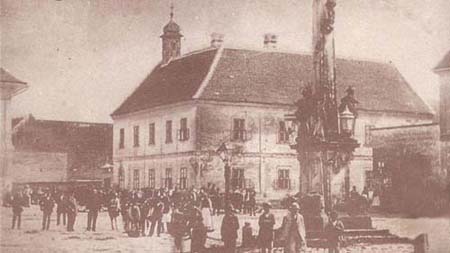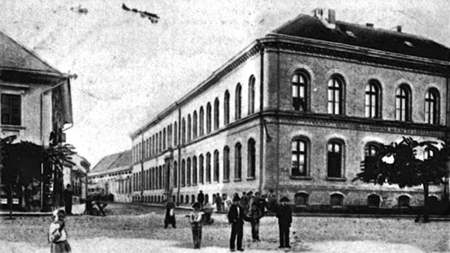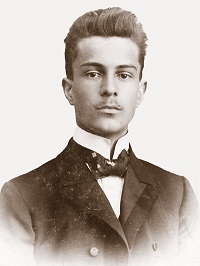THE HISTORY OF THE SCHOOL
The public grammar school in Sombor was officially opened on 15th October 1872 and it started working on 11th November that same year. Classes were initially held in Serbian and Hungarian.
In its first school year 1872/73, the grammar school in Sombor had 4 lower grades in which there were 86 students. Within the next few years, several higher grades were opened, so in the school year of 1876/77 the grammar school had all 8 grades. The number of students had been getting larger every year that passed.

Grammar School „Veljko Petrović“ had also been working during The First World War (1914-1918). Since the school building was also being used as a military hospital at the time, classes had to be held in two shifts during the day. Soon after the liberation of all Yugoslovenian people and after the creation of the first Yugoslovenian country (1st December 1918), which was in its first years called The Monarchy of Serbs, Croats and Slovenians, Serbs that had lived in the liberated town of Sombor pleaded to the Ministry of Education in Belgrade to approve of the opening of a state grammar school in the Serbo-Croatian language. The answer was positive and in the beginning of the year 1919 a state grammar school in the Serbo-Croatian language was opened. In the years that preceded The Second World War, political events and the work of youth organisations had affected most of the students of the grammar school in Sombor, other youngsters in schools as well as working people, to have anti-fascistic views and to be ready to fight the fascists. That’s how, according to some data, 47 of brave and heroic students gave their life for the final liberation of the country.

The best period in the history of the grammar school in Sombor began with the renovations that came soon after the liberation. Classes were held according to the Class plan of the Military administration for Banat, Bačka and Baranja. It was mostly a brief plan created before the War that had no mandatory classes on religion. From the beginning of the school year of 1945/46 the school started working according to a new plan made by The Ministry of Education. The biggest changes were made to the grammar schools in the years that followed after 1945. The classes were divided into two programs: one that focused on natural sciences and mathematics and one that focused on social sciences and languages.
Sports, art and science extracurriculars had always had great success in many competitions and had won many trophies. Thanks to these activities, the whole cultural and sports life of the youth in Sombor became better and more stable.
The best conditions for organising this educational institution were obtained in 1971.
During 1972 the whole building of the „Veljko Petrović“ grammar school had been renovated. The school received help for this from the Sombor Town hall and „Akumulator“.
Its 100th year anniversary was celebrated in 1972. For this occasion, a book named „One hundred years of the grammar school in Sombor“ was published, and its authors were: Bodor Antal, Leposava Maširević, Sreten Opačić and Radmila Kovčin.
With the reformations of high school education, after 106 years, the grammar school in Sombor had stopped working. Incomplete data state that, by 1978, 5512 students took the end-of-high-school-exam, of which 4220 studenst finished this grammar school by the beginning of The Second World War.
This high school education reform in 1974 had been iniciated by political factors in the country. After several years of indecisivness, the Ministry of Education decided to re-open this school.
In the school year 1990/91, the grammar school in Sombor was re-opened and returned to its previous address: Dositejeva street 2.
The place, role and tasks of the grammar school in Sombor throughout its existence and work were conditioned by historical happenings and political needs. Depending on the historical changes of frames put there by the state and law enforcement, the grammar school had been changing in order to fit the needs of the people which it served with its work.
The grammar school had been continuously playing its role as a first-class factor in the increase of culture and advancement in general. In organising its work, the school has made such a program, through which its students are made competent to intelectually and morally contribute to a more advanced and beautiful life.
The education which they got in the grammar school in Sombor, enabled many students to become famous experts. The list of great Sombor's grammar school students is really long. Here are some names: Veljko Petrović, an academic and writer; Milan Konjović, and academic and painter; Sima Ćirković, an academic and doctor of historical sciences; Mladen Leskovac, an academic and writer; scientist dr Rajuko Tomović and dr Bogdan Maglić; Ivan Gutman, an academic and scientist; Dušan Trbojević, a piano player and so many more.
On the suggestion made by The Council of the grammar school and with the decision of the City Hall in Sombor, this school changed its name to „Veljko Petrović“.

Veljko Petrović was born on 5th February 1884 in Sombor. He graduated the grammar school in Sombor in 1902 and got his law degree in Budapest.
On the crossroads of two epochs, Veljko Petrović had made a significant contribution to the development of Serbian literature. He made patriotic poetry better and released Serbian prose from the chains of folcor-descriptive writing.
People, the town and the children's world confronted with nature's secrets are the main topics of Veljko Petrović's works.
„Bunja and others in Ravangrad“ from 1921 was his first literary work. Sombor, as Ravangrad, enters Serbian literature and fate and spirit of history, fate and spirit of our human's life.
Veljko Petrović had been a member of Serbian academy of science and art since 1936.
He died in Belgrade on 27th July 1967 and was burried in the Alley of great people.





